Victoria Wynne-Jones
Over several decades, US-based coach Greg Glassman developed a fitness regime known as CrossFit, the aim of which is to ‘forge a broad, general and inclusive fitness.’[1] Designed to optimize fitness through constantly varied functional movements performed at high intensity, CrossFit is also the name of the community that spontaneously arises when several people do these workouts together. After examining various sports and physical tasks collectively, skills and adaptations that could lend themselves to performance advantage were sought out. According to the official CrossFit website, ‘Capacity culled from the intersection of all sports demands would quite logically lend itself well to all sport. In sum, our specialty is not specializing.’ Currently sponsored by Reebok, CrossFit has become a worldwide phenomenon since the early 2000s, with more than 11,000 affiliated gymnasiums. For every summer since 2007, the CrossFit Games have crowned the Fittest Man and Woman on Earth. The CrossFit website includes the date and a Workout of the Day (WOD) so that ‘anyone with an Internet connection and the willingness, curiosity and bravery to try it, could.’ From a single gymnasium in Santa Cruz, California sprung a worldwide CrossFit community whose members all manifest Glassman’s equation: that a regimen of constantly varied, functional movements performed at high intensity in a communal environment leads to health and fitness.
Perhaps CrossFit might serve as a point of departure for an examination of athleticism and ineptitude in contemporary New Zealand performance art. Recent performances share the inclusive spirit of CrossFit, particularly its occasional tendency towards the homo-social, as well as its dogged perseverance and unabashed embrace of the excessive. Having participated in CrossFit for several years, Auckland-based artist Timothy Wagg noted that when pushed to physical exhaustion through physical exercise:
…you become both more and less aware of your own body. You discover limits, how much you can lift or how fast you can run. You feel your body working, the interior operations that usually work in the background unnoticed, become the sole focus. Your lungs, heart and muscles all suddenly appear to you.[2]
Wagg noticed that after doing CrossFit the physical exhaustion and pain he felt made simple and habitual movements strenuous. The day after undertaking the CrossFit As Many Rounds as Possible (A. M. R. A. P.) thirty minutes of push-ups Wagg noted an ‘almost hyper-sensitivity’ to his body:
I felt my arms in a different way, they were stiff and hurt so much that I could barely raise them. Normally simple actions became strenuous. To put in my head phones I had to rest my arms on a table, raise them parallel to my body, then extend my head forward.[3]
The use of language in CrossFit such as (A. M. R. A. P.) encourages amelioration and self-mastery, challenging what one thinks one’s body is capable of as well as exceeding one’s own personal best. The idea is to complete as many repetitions or reps as one can, aiming for the maximum amount within a certain period of time. If athleticism involves competition for a prize, then in CrossFit the thing competed for is fitness, improvement, the successful completion of goals, and beating one’s former time. Even slightly ineffable, one of the official goals of CrossFit is physical preparation for ‘any physical contingency – not only for the unknown, but for the unknowable.’[4] The telos or purpose is the successful achievement of tasks, to obtain strength, fitness, and control. The apotheoses of this training are the men and women who compete in the CrossFit games, heroic athletes successfully performing the range of tasks that are thrown their way.[5]
Sport, in particular rugby football, is an integral part of mass hegemonic masculinity in New Zealand. Similar to the athletes crowned at the CrossFit games, the apotheoses of this dominant cultural identity are the members of the national rugby team, the All Blacks. These particular athletes are made highly visible through pervasive advertising and marketing, as peons of masculinity as well as aggression, strength and stamina. Like CrossFit, professional sports such as rugby tend to create a system with which to measure the capacity and appearance of bodies. Grand narratives of discipline, perfection and success are communicated through the semiotics of reading body actions – running, kicking, leaping, throwing – creating a typography of acceptable normative gestures and postures that are formulaic as well as over-coded. There is an unadulterated universalism of the body in action performing measurable achievements until a system of repressions is erected, whereby any difference or deviation is either relegated to the ‘special’ or subsumed into an ideal unity, the ultimate human or ‘the fittest on earth.’ It is within a context of such normative and stoic masculinity that performances by cis-gendered male performance artists such as Wagg can be read.
What the artists discussed in this essay perform is a kind of schizoid-athleticism, applying a qualifier taken from philosopher Félix Guattari (1930-1992) to propose an athleticism that is complexified and enriched it so that it might be more varied and heterogeneous.[6] The recognizable formats of athletic training and sports are utilized by performance artists so that there is a bio-political fragmentation of unified, whole bodies. Competent and completed actions are frustrated so that the dominant or molar narratives of athleticism, including ideal physical forms, fitness, progress and triumph, can be dispersed or molecularized through schizo-athletic strategies of iteration, fragmentation, incompetence and failure. In doing so, dominant hierarchies of bodies as well as accounts of gender identity, nationalism and productivity are tested.

Timothy Wagg, Untitled Performance, 2012. Artspace, Auckland. Image courtesy Timothy Wagg.
Incorporating his experience with CrossFit into his artistic practice, Wagg and another CrossFit trainee gave a performance at Auckland’s Artspace gallery involving the first open workout of the 2012 CrossFit Games. This involved seven minutes of squat thrusts or burpees to the regulations of the games while a seven-minute long track of heavy-metal music was played.[7] A burpee in this case involves jumping and touching a mark six inches above one’s normal reach, lowering the body into a squatting position, jumping the feet backwards to form a plank position, lowering down until the chest has reached the floor, executing one push-up, then jumping the feet back towards the hands, and standing up to repeat the sequence. Two judges presided over the performers, counting and making sure technique was correct.
Harking back to an assertion of phenomenologist Maurice Merleau-Ponty (1908-1961), Wagg noted in his dissertation that CrossFit as well as the apparatus of the paint-brush and the video camera all enhance his awareness of his own body.[8] Just as CrossFit depends on a great deal of strength and endurance, painting is often dependent on manual dexterity and control. Similarly, hand-held filming is dependent on stillness, balance and strength. Wagg reflects that within the videos made for his installation Body Manoeuvre (2013) there are mistakes. One can see the artist’s inability to hold poses, the camera does not act in the way he planned and what is made visible is a body faltering.[9] In terms of a wider, international art context, in his own writing Wagg refers to documentation of work by US artist Matthew Barney; in particular, his Drawing Restraint 2 (1988) in which Barney, who boasts a past as an athlete on the football field, holds onto a bar that extends from his studio wall with his feet positioned on the wall for balance. From this position, he uses a long drawing implement to create a mark on a pad of paper attached to the ceiling. The sheer size and weight of the implement would have made it difficult to maneuver. Additionally, Barney has a bungee cord attached to his legs so that it would be more difficult to control his body as he pushes himself away from the centre of the room. Any action, movement or mark-making therefore requires extreme strength and physical resistance, demonstrating Wagg’s use of Barney as a model artist/athlete as well as mark-maker, one who activates and augments the brute physicality and performative activity of creating an artwork, making strenuous movements that might previously be quite simple.
It must also be noted that Barney takes this notion of self-imposed restraint or impediments to an extreme in his video works, such as the 89-minute long Blind Perineum (1991) in which he uses hooks and rock-climbing equipment to scale internal walls whilst naked and with an ice-pick inserted into his rectum. At the time it was exhibited, Barney had graduated from Yale and was also working as a male model; the prestige and celebrity he enjoyed highlighted his radical undoing of tropes of masculinist athletics even more.[10] Blind Perineum challenges an understanding of gendered athletic endurance where male aesthetic coherence underpins the image of the male body as a weapon or hard projectile aimed at the world. Instead, Barney’s act of masochistic endurance suggests a kind of schizoid trans-athleticism, a queering, where anal penetration of the sealed, classical body becomes integral to the identity of the athletic body. Aesthetic athleticism is thereby redefined as a ‘heroic’ endurance of anal penetration, and conversely, anal penetration becomes athletic. In Blind Perineum, Barney’s act deconstructs the athletic restraint involved in maintaining the normative image of male virility based on repressing or denying the anus, and in doing so, challenges presuppositions about heteronormative uses of bodies in art.[11]
Wagg’s Body Manoeuvre is composed of a series of paintings in a temporary unstable mix of oil paint, beeswax and linseed oil in fluorescent green on white gesso supports, some canvas, and other rudimentary panels like doors propped up by simple timber triangle jacks. These panels were placed within the gallery space alongside three monitors so that visitors were required to walk right inside the space and around in order to view each of the paintings and video works. Paint was applied with large, stiff, flat objects in long, slow gestures so that it was spread along before coagulating, impasto-like. Gestural marks were also made on the walls with spray paint in a similar green based on the color of the trimmings of the sneakers Wagg can be seen wearing in his video works, the Asics Gel Resolution 4 Men shoes. Each and every green mark made is a trace of prior movement, a haphazard record of error or success. Continuing from the self-conscious and self-reflexive brushstrokes enlarged by US painter Franz Kline (1910-1962), and made subtle, striped or sprayed by French painter Martin Barré (1924-1993), Wagg also inserts his paintings in a lineage of contemporary painters such as Laura Owens and Jonathan Binet. They are comparable to Owens’ labored, stylized scribble and Binet’s focus on premeditated and embodied mark-making, or traces as trophy.

Timothy Wagg, Body Manoeuvre, 2013. Elam Graduate Show 2013, Elam School of Fine Arts, University of Auckland. Image courtesy Timothy Wagg.
The video Body Manoeuvre begins with a downward perspective revealing a battered cement floor, Wagg’s worn sneakers and a partial view of his legs clad in blue jeans. The camera zooms too quickly, struggling to focus, while the framing and aperture are clumsily adjusted. Then from this point of view (Wagg is filming himself), the artist stands on his left leg and slowly lifts his right foot and leg to the side and behind his body as he attempts to film his right foot. As the foot and leg slowly ascend the left leg fights for balance, wobbling and trembling, subsequently destabilizing the camera. Wagg slowly lifts his foot higher and higher until we see the wall and windows behind him. Struggling to keep his balance, he shakes, then adjusts himself to regain control, then shaking again, he drops the position, hops and recovers before trying once more. Borrowing a description from Auckland-based performance theorist and artist Christopher Braddock, Wagg sets up an event ‘which will, by nature, fail expectations.’[12] In failing to film smoothly and competently, in failing to be strong enough to hold his balance and execute his pose, Wagg films a sense of failure. He cannot achieve what he appears to set out to do, so that there is, in the words of Braddock, ‘a steady deferring of anything that might structurally function or represent a whole.’[13] In the first three iterations of the pose the video is all in one shot, yet Wagg also deviates from this. Being forced to edit, to cut the shot and begin another—one with noticeably different ambient light—he fails to achieve continuity. The actions in Body Manoeuvre are a little strenuous but not really athletic; they in no way approach the high intensity and constant variation advocated by CrossFit, but are ‘open to interpretation’, requiring a viewer to evaluate or add value. To use a phrase from Braddock once again, Wagg creates a sense of functional frustration. In viewing the iterations within this video there is a desire for Wagg to succeed, to approximate athleticism, to hold his pose, to film competently, and to ‘undo failure.’
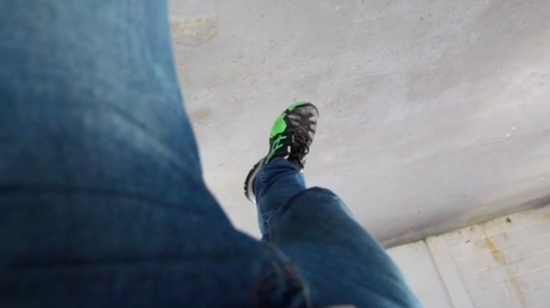
Timothy Wagg, Body Manoeuvre, 2013, still taken from single channel digital video filmed on Canon 5D, duration 3min 16secs, https://vimeo.com/80443833. Image courtesy Timothy Wagg.
Rather than athleticism, Body Manoeuvre demonstrates physical and technical ineptitude and a sincere yet casual interest in physical activities of posing and filming. Wagg’s apparel, the combination of sport shoes with jeans and a t-shirt, is repeated in a more recent work I would rather be the worst at something than the best (2014) in which the artist films his double, this time wearing Reebok Crossfit Sprint TR Men’s Sage shoes, black trousers and a t-shirt.[14] The double is filmed struggling to traverse an abandoned industrial lot, slipping and struggling to find grip in the uneven and sloping clay-like soil, weeds and detritus. The soundtrack is made up of Wagg’s voice whispering:
I’m not really sure where I am at the moment, I don’t think I’ve come down here before. I’m just trying to improvise movements through it, but it’s difficult to find my footing… There’s this ringing in my right ear, and my left leg’s nearly dead, I need to slow down what I look at… I don’t want to get good at anything. I’d rather be the worst at something than… I can’t stabilize myself. My right hand struggles to find something secure to grasp. I move onto the ground and just look up.
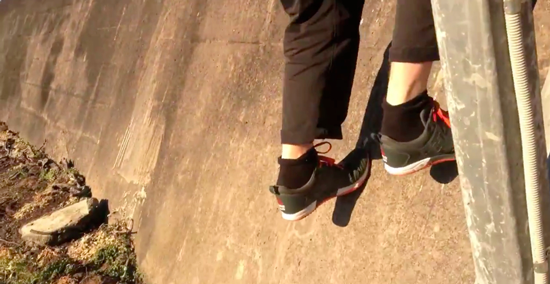
Timothy Wagg, I would rather be the worst at something than the best, 2014, still taken from single channel HD video filmed on iPhone 5, duration 4 mins 18 secs, https://vimeo.com/117976762.
In fact, Wagg’s attendance at CrossFit training is inconsistent and sporadic. There is doubt as to whether he has obtained a broad, general and inclusive fitness. It is far more likely that he approximates the worst at something than the best. His patchy participation in CrossFit recalls the current trend for nutritional detoxification as a temporary remedy for binge-drinking, attempts to adhere to a raw foods diet for three days or that of popular celebrities to follow a vegan diet for 22 days. Yet Wagg continues to wear his CrossFit trainers and their presence in his video works as casual accoutrements of athleticism points to what could be another aspect of schizoid-athleticism, the phenomenon of normcore, described by Rory Rowan as a slippery mix of ‘fashion trend,’ ‘socio-cultural concept’ and ‘downtown in-joke.’[15] Toying with changing relationships between difference, normality and sameness, a predominant aspect of normcore involves ‘dressing normal’ as ‘the latest form of cool.’ Here dressing normal is said to evoke as models the 1990s comedian Jerry Seinfeld, late CEO Steve Jobs and middle-class American tourists, whereas, in fact, Seinfeld’s combination of sneakers and jeans has morphed into normcore’s predilection for sportswear, particularly athletic shoes. Here footwear designed for running and clothing designed for temperature control, ease of movement and aerodynamic streamlining is donned everyday by those who do not participate in any form of athleticism. The sneakers and leggings from sportswear have become for some a kind of leisurewear demonstrating a sportif uniform of inaction and lassitude. In this instance, the term sportif evokes the dispositif of theorist Michel Foucault (1926-1984) as a ‘thoroughly heterogeneous ensemble,’ an apparatus composed of elements that are modish, sociological, commercial, scientific, and aesthetic as well as athletic.[16]
Leisurewear has also been included in installations by Melbourne-based artist Alex Vivian. A frequent motif in Vivian’s assemblages is the white athletic tube-sock in addition to men’s underwear, baseball caps and hooded sweatshirts. As part of his exhibition Breakfast stains decorate a hooded sweatshirt (ideas to be laundered) at Galleria, Perth in 2012, Vivian clothed a small plinth with a bleached, inside out sweatshirt and used it as a support for an overhead projector displaying the artist’s poetry. This was his hat involved a baseball cap stained with sea-salt and dirt balancing atop a tall metal stand. In the very same exhibition, Vivian filled cracks in the black gallery wall with white, viscous Deep Heat, a potent-smelling mentholated cream rubbed into muscles to relieve pain after exercise. Vivian has often utilized such olfactory prompts to point towards exertion, masculinity and streetwear. Previously he used Vaseline (a material also utilized by Barney) to cover advertisements for Calvin Klein underwear, and in 2011 his A wall… Visited, leant against, etc. etc. at Hopkinson Mossman in Auckland involved repeatedly rubbing blue denim jeans against the white gallery wall so that acts of leaning or idleness left a visible trace, a staining blueness. Vivian employs substances and apparel that belong in locker rooms or college dormitories in order to point towards affects of bodies and their ability to contaminate. Soiled, sweaty and stained clothing indicate temporary states, a past athleticism as well as a metonymy of or indication towards absent bodies. It is unclear as to whether these athletic bodies were triumphant, whether or not they achieved the thing they set out to accomplish, and whether they obtained the prize, though it is highly likely that all of the clothing belonged to the artist and is merely part of his own quotidian athletic apparel.
The exertion of the squat thrusts performed by Wagg and a fellow trainee harks back to Jumping Guy, a video by Berlin-based New Zealand artist Alicia Frankovich, in which a young man ceaselessly jumps up and down. Upon entering the exhibition of works by finalists in the 2012 Walters Prize at the Auckland Art Gallery, one was first confronted with projected video in a darkened space as part of Frankovich’s Floor Resistance. Even before entering, a rhythmic and relentless beating sound could be heard, accompanied by repetitive staccato breaths. The video itself shows a young man—a dancer named Martin—jumping up and down, again and again amongst seated spectators and within a black-walled space.[17] Martin is exuberant, jumping almost mechanically, indefinitely, vigorously yet aimlessly. There is the pattern and sound of exertion, his feet landing on the ground in tandem then springing his body upwards once more as he pants, exhausting himself while affirmatively nodding his head and making odd circular gestures with his hands and arms. These seem to aid him in his propulsion of himself upwards and downwards but they also appear to signal encouragement, or complicity to the seated spectators.
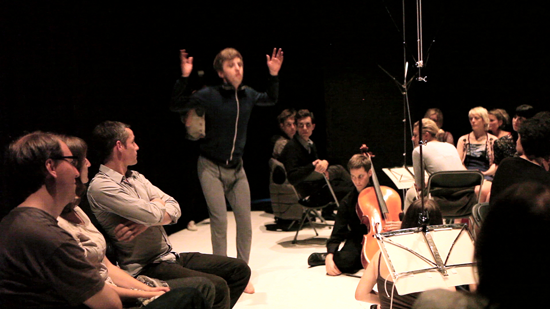
Alicia Frankovich, Jumping Guy in Floor Resistance, performance detail, 2011, Hebbel Am Uferm HAU 3, Berlin. Image courtesy Alicia Frankovich.
Frankovich refers to her jumping guy as ‘an interloper,’ ‘a wild card’ or ‘gate crasher,’ someone who interrupts or intervenes within an event. In directing Martin to jump up and down, an action previously enacted by her earlier sculptural work Slow Dance (2011) in which a piece of wood is attached to a motor so that is slowly lifted up and down, Frankovich directed the dancer to use his very limbs and body in a ‘rudimentary’ way, ‘like a plank.’ Pulsing in time, jumping up and down, breathing in and out, he is both energized and exhausting. Mobilizing the brute matter and forces of his body, he becomes out of breath, momentarily defying gravity, resisting it, bouncing, then falling back to the earth again. The punctum of Jumping Guy is his attire; he appears to be wearing mismatched athletic gear in shades of grey marle. Perhaps these are the clothes he sleeps in? They also resemble long underwear, baggy and comfortable, contrasting greatly with the formal clothing of those gathered to witness the performance. Similar to Wagg and Vivian, a young man is dressed for comfort in clothes bearing the features of sportswear: grey marle stretch fabric, zips and a hood. Frankovich’s Jumping Guy is loose, purposeless, enthusiastic, energized and relentless; he might also act as another emblem for recent enactments of masculinity in contemporary New Zealand performance art.
If performance indeed involves a display of some kind of behavior, then a crucial decision for an artist is the selection of action from many. In a 1952 diary entry, US artist Yvonne Rainer imagined the urban field of New York City around her, and the vast range of activities being carried out in simultaneity with her performances. The 18 million inhabitants of the city at that time were ‘sleeping, awaking, dressing, eating, crapping, working, copulating, bathing.’[18] According to Rainer’s contemplations, any live event that is a performance is only a small section of activity within a larger and expansive field of human action. Martin’s acts of jumping are deceptively simple, and contemporary New Zealand performance artists are frequently selecting quotidian rather than athletic actions, ones that take place everyday. These are then repeated within a performance context so that they might be displaced; actions are isolated, then iterated, so that they are made strange. This anti-athleticism questions forms of behavior or rituals often associated with more dominant ideas of masculinity such as those mentioned before, for example rugby and other professional sports. The performances discussed within this essay are by young, white, cis-gendered men, reflecting a current trend in contemporary New Zealand performance art for such artists to interrogate the pressures and privileges they enjoy. It should also be noted that at the same time artists such as val smith and Virginia Kennard explore queer identities in their performances, while Jeremy Leatinu’u, John Vea and Kalisolaite Uhila explore their Pacific heritage within specific urban environments.
Many of the performances by young, white, male artists involve mundane acts of cleanliness, perhaps harking back to Billy Apple’s Negative Cleaning Conditions in the early 1970s or Phil Dadson’s Purposeless Work (1971) in which a group of performers swept the shoreline of Karekare beach with large brooms.[19] Daniel Webby’s Blind Pig at Rm gallery on Karangahape Road in 2010 involved the artist tending to his body, slowly washing himself in a large concrete tub. He then purified some of the bath water through a rudimentary coal filter, poured the liquid into small glasses and handed them to audience members on a tray for them to drink. The submersion of self into water before an audience recalls public baptisms, whether televised or painted in frescoes. The artist’s encouragement to audience members to imbibe his bath water also recalls the ritual of the Eucharist, elevating him, almost canonizing him, forcing audience members to engage in an intimate act of communion with the performer, challenging notions of cleanliness and propriety. Webby posits himself, the artist, as both evangelistic and banal rather than athletic and heroic.
Recalling Rainer’s reflection upon the greater field of human actions is Campbell Patterson’s Long and Slow from his solo exhibition ‘So Tired’ at Michael Lett in 2012. In a masochistic iteration of the prototypically manly act of daily removing the hair from one’s face, Patterson filmed himself slowly plucking out his mustache, hair by hair. Presented on a flat screen television placed on the ground, installed before a pink and black floral patterned blanket, the duration of the piece is 97 minutes and 56 seconds. Whereas a similar work by Vito Acconci—his 1970 film Openings—saw the artist removing the hairs from around his navel in order to transgress his masculinity and perform a certain femininity,[20] Patterson’s Long and Slow could be read as an act of commiseration, the painful and prolonged repetition of a simple act of hair removal performed by millions of men around the world who shave their faces every day. This repetition harks back to the reps, sets and sequences of CrossFit or indeed any athletic training, as well as the everyday grind of pain and perseverance. Patterson’s attempt to create transcendence over or through a docile body by slowing down, drawing out and complicating the act of hair removal also recalls athleticism as a series of small, local and sordid acts of self-discipline that are then co-opted by larger capitalist and nationalist narratives.[21] Recalling Wagg’s A.M.R.A.P. push-ups, Patterson’s Lifting My Mother For as Long as I Can (2006-2011) involved the artist filming himself lifting his mother for as long as possible in front of the curtains of his parents’ home once a year, for five years, on his mother’s birthday. Beginning as the simple sculptural idea of a formal relationship as ‘one object carrying another,’ the series of five videos enacts odd yet touching actions, a weight-lifting of the mother by the son/artist, a physical act that recalls the uniquely maternal act of carrying another within one’s womb and body.[22]
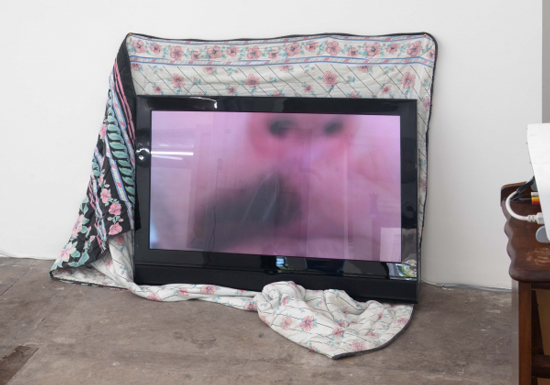
Campbell Patterson, Long and Slow, 2011, digital video on DVD, 97 mins 56 secs. Image courtesy Michael Lett.
UK based film theorist Richard Dyer posited a project of making ‘whiteness’ strange, taking something ubiquitous and making it other, decentering it so that it might be interrogated and its dominance diffused.[23] A central thread in recent New Zealand performance could be said to be the ‘crisis of masculinity,’ as cis-gendered male artists seek to make masculinity strange, pulling it apart, contesting the idea that it is non-gendered. French theorist Gilles Deleuze (1925-1995) together with Guattari wrote that ‘There is no becoming-man because man is the molar entity par excellence, whereas becomings are molecular.’[24] If ‘man’ is the default, the assumed position, then how can one visibly enact such a position in a ludic and molecular or destabilizing manner? According to theorist Judith Butler any gender identity is ‘tenuously constituted in time’ and ‘instituted through a stylized repetition of acts.’[25] And, recalling Butler, a destabilizing of gender is frequently accomplished by repeating typically masculine actions or activities with difference and via performance. Activities which might usually be restricted to private realms such as exercising, cleaning or shaving oneself are playfully displayed and made public, often within a gallery context.
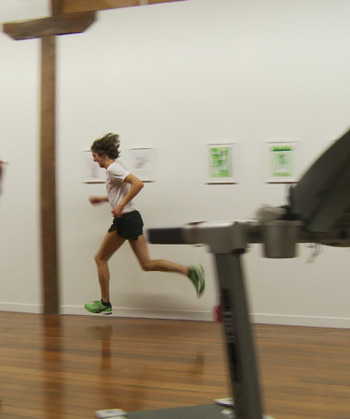
Ryan Ballinger, Indoor Record Attempt #1 (Fukuoka revisited), 2012, video still from performance on the occasion of the opening of ‘Poetry in Motion’ Saatchi & Saatchi Gallery, Auckland, 2012.
This repetition of commonplace actions with difference links to the notion that performance is displayed behavior that is framed by its context, its new situation, what currently surrounds it. Performances are transformed by and can transform the gallery space, interfering with the rational semiotic order, sanity, decorum and apparent cleanliness of the white cube by introducing a subversive playfulness. According to anthropologist Roger Callois, certain sorts of play might have a vertiginous effect, interfering with the stability of perception and inflicting ‘a kind of voluptuous panic upon an otherwise lucid mind.’[26] New Plymouth-based artist Ryan Ballinger disrupts such a context through insertions of his own athleticism. The son of Paul Ballinger, who won the Fukuoka Marathon in 1982 setting a New Zealand record of two hours, ten minutes and fifteen seconds, Ryan Ballinger uses this time to structure his own performances in which he runs to and from, around or within galleries, sometimes on a treadmill.[27] Ballinger takes as his point of departure the ancient Greek format of the marathon and uses a temporal structure created by his father in order to excessively repeat instances of running. Obsessed by the marathon format as well as the legacy handed down by his father, Ballinger repeatedly performs marathons again and again. Within her seminal text ‘Sorties,’ French philosopher Hélène Cixous pointed out that the excessive is often attributed to the feminine; women are often said to ‘go too far’ or ‘be too much.’[28] However, excess is a schizo-athletic strategy being utilized by certain male performance artists like Ballinger, repeating normative masculine and athletic actions so that they are extended throughout tortuous periods of time, performed with additional gusto and exertion or rendered more painful and hazardous. They behave as expected, but in an unruly in-disciplined manner, and in novel circumstances, enacting an athleticism of banality.
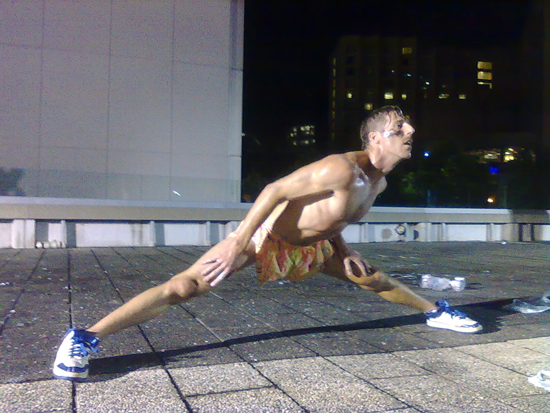
Joshua Rutter, Dance Like A Butterfly Dream Boy, 2012. New Performance Festival, Aotea Centre, Auckland. Image courtesy of Joshua Rutter.
An elaborate example of men performing masculinity in order to make it strange is Auckland-based choreographer Joshua Rutter’s Dance Like A Butterfly Dream Boy first performed at the New Performance Festival on the roof of Aotea Centre in 2012. As part of this work, a large group of men dressed once again in sporty attire executed a wide variety of actions or synthetic rites habitually associated with Pakeha masculinity.[29] These ranged from demonstrations of rigid, masochistic and narcissistic athleticism to bestial acts of becoming-animal as well as playful and mournful coming of age rituals. Structured into sets, punctuated by air horns and slowed-down commands from inspirational audio-books, the performers submitted themselves to a grueling regime, rotating between miscellaneous exercises. Recalling CrossFit, activities included the performance of elaborate permutations of press-ups and sit-ups; similar to Vivian’s installations, they also sprayed each other with potent deodorant, coated themselves in hair gel and drank, then ejaculated, energy drinks into each others’ faces. As a large chorus, they engaged in serious yet pointless contests including combat by packing tape. They sculled back beer, clustered together into a ruck, clutching upwards with yearning, then danced beneath strobe lights. The piece was conceived after Rutter began taking boxing lessons and reflected that he had since become ‘more aggressive, confident and classically masculine.’ Tellingly, it is the repetition and performance of skipping, a form of exercise often used by boxers that is also quite girlish, that complicates matters. As Rutter and his fellow performers skipped and dreamily lip-synched to a pop-song with graceful, joyous and unabashed exuberance, they scrambled the opposition of masculine and feminine, and in doing so, playfully pulled apart predominant assumptions about masculinity.
Artists such as Rutter, Brent Harris and Mark Harvey who were originally trained in dance often make use of performance as a way in which to evade the discipline of this subject, resisting the ways in which dancers are frequently manipulated by choreographers or scores, expected to be perfect, youthful and ideally beautiful, to dance on command, and to move with apparent ease, performing virtuosic and impressive actions before an audience. All three artists instead make visible bodies that are imperfect, messy, contagious, affective and awkward. Included within his pack of performers, Rutter cast bodies which are aged, flabby, feeble, ill-kept, untrained, weedy, and tired. In works such as his poring as part of the Oct/Dec series hosted by St Paul Street Gallery in 2011, Harris created encounters in which spectators were confronted with agonizing attempts at performing as well as dissections of rehearsal as repetition. Harris is anything but heroic; above all, he iterates the character of the hapless and hopeless male, consciously performing his own idiosyncratic quirks, deferrals and failed gags. He hesitantly tells his spectators ‘ahm… ok… it’s alright… it’s a bit manic today… ok… if you like… I am expecting more people… we won’t do it now…’ Like Wagg, Harris continually performs ineptitude, stretching out failed attempts and thwarted actions again and again in performances that sometimes last as long as two hours, repeatedly and self-consciously failing before an audience. In the sixth part of Harvey’s I am a Wee Bit Stumped performed at the Newton Old Folks Association Hall, also in 2011, spectators were told by helpers that if they would like Harvey to move then they needed to whisper into his ear why they think he should move and ‘if he feels convinced by any reasons given then he will move ten centimetres.’ In this work, spectators were faced with a performer trained in dance who was frozen, assuming a position of stubborn stillness, perhaps even of performance anxiety. Harvey, like Harris, presents himself as a bad performer, one who is unsuccessful or who cannot find a reason to perform. If attendees wanted Harvey to move, to be a productive dancer and participate in movement, then they had to give him a compelling reason to do so.[30]
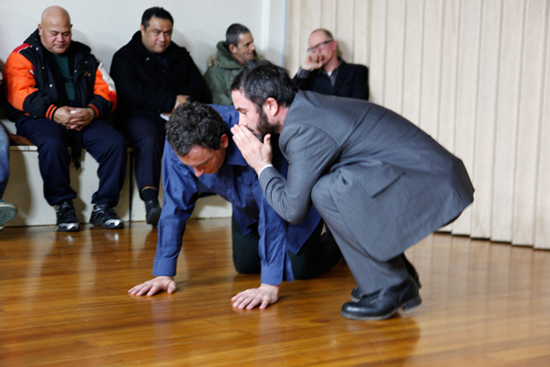
Mark Harvey, Sixth Test: Proposed crescendo: any suggestions? In I am a Wee Bit Stumped, performance detail, 2011. Newton Old Folks Association Hall, Auckland.
Choreographer and dancer Jonathan Burrows once wrote that ‘It’s hard to find a reason to jump.’[31] It might be difficult to find a reason to be as exuberant as Jumping Guy, to defy gravity again and again and create a contagious rhythm with boundless energy. One reason to jump, to physically strive or to perform might be to perform a schizoid-athleticism in the hope of dismantling or at least probing normative concepts of masculinity, interrogating them, demonstrating their ambiguity and contradictions, making them strange and, in doing so, provoking or enabling a questioning of received notions of gender. As demonstrated by Wagg and Vivian, this might also be achieved via assemblage, gestural painting and hand-held filming, whereas performers like Webby, Patterson, Rutter, Harris and Harvey do so by playfully selecting actions from a field of many, performing, repeating and fracturing incidents of cleansing, extracting, skipping, hesitation and panic. True to the spirit and equation of CrossFit, something is to be gained by a regime of iterated functional movements performed in a communal environment.
Some parts of this essay originally appeared in Art New Zealand 149, Autumn 2014.
[1] “What is CrossFit?: Forging Elite Fitness.” CrossFit: Forging Elite Fitness. Accessed February 14, 2015. http://www.crossfit.com/cf-info/CF-contact.html
[2] Wagg, Timothy. “Body Apparatus.” Diss. University of Auckland, 2013. 1. Print.
[5] “About the Games: CrossFit Games.” Reebok CrossFit Games 2015. Accessed February 14, 2015. http://games.crossfit.com/about-the-games
[6] Guattari, Félix. Chaosmosis an ethico-aesthetic paradigm. Translated by Paul Bains and Julian Pefanis. (Bloomington and Indianapolis: Indiana University Press, 1995) 61.
[7] Wagg, Timothy (artist), email message to the author, February 11, 2015.
[8] Merleau-Ponty, Maurice. Phenomenology of Perception. Trans. Colin Smith (London and New York: Routledge, 1958), 112.
[9] Body Manoeuvre was exhibited as part of the Elam Graduate Show at the University of Auckland in 2013.
[10] Chin, Daryl ‘Theories of Cultural Relativity,’ in Performing Arts Journal 16:1, 1994, 87-101.
[11] Quoted with permission from correspondence with Minissale, Gregory (art historian) email message to the author, May 24, 2015.
[12] Braddock, Christopher ‘Alicia Frankovich and the force of failure’ in Column 5 (Sydney: Artspace, 2010), 8.
[14] I would rather be the worst at something than the best (2014) was exhibited at Blue Oyster Art Project Space, Dunedin as part of ‘Probstian Aesthetic’ curated by Dan Arps, 19 November – 20 December, 2014.
[15] Rowan, Rory ‘SO NOW!: On Normcore’ e-flux journal #58 October 2014 “quasi-events” 4.
[16] Michel Foucault quoted in ‘The Confession of the Flesh’ in Foucault, Michel Power/Knowledge: Selected Interviews & Other Writings 1972-1977. Ed. Colin Gordon (New York: Pantheon Books, 1980), 194.
[17] Alicia Frankovich quoted in ‘Interviews with the Curator Natasha Conland’ The Walters Prize 2012 (Auckland: Auckland Art Gallery Toi o Tamaki, 2012), 19.
[18] Yvonne Rainer quoted in Wood, Catherine. Yvonne Rainer: The Mind is a Muscle (London: Afterall Books, 2007), 1.
[19] It is also important to note that although the majority of solo performances by male artists assembled beneath the banner of Post-Object Art in the mid 1970s to 1980s were undeniably strong and aggressively masculine, they were not self-reflexively or self-consciously so. An important exception would be Jim Allen’s performance of Kim Gray’s Sweater at the Experimental Art Foundation, Adelaide in 1976 in which Allen selflessly and generously agreed to perform the work in lieu of the absent artist.
[20] Jones, Amelia. Body Art: Performing the Subject (Minneapolis: University of Minnesota Press, 1995), 108.
[21] This concept of the docile body is taken from Michel Foucault, Discipline and Punish: The Birth of the Prison. Trans. Alan Sheridan (London: Penguin Books, 1977), 136.
[22] Campbell Patterson quoted by Parlane, Anna ‘Campbell Patterson: Lifting My Mother For As Long As I Can (2006-ongoing)’ in Conland, Natasha Made Active: The Chartwell Show (Auckland: Auckland Art Gallery, Toi o Tamaki, 2012), 112.
[23] Dyer, Richard. White (London: Routledge, 1997), 4.
[24] Deleuze, Gilles and Guattari, Félix. A Thousand Plateaus. Trans. Brian Massumi (London and New York: Continuum, 2008), 322.
[25] Butler, Judith. ‘Performative Acts and Gender Constitution: An Essay in Phenomenology and Feminist Theory’ Theatre Journal Vol.40, No. 4 (Dec., 1988) The Johns Hopkins University Press, 519.
[26] Roger Callois quoted in Marvin Carlson Performance: A Critical Introduction (New York and London: Routledge, 2004), 21.
[27] Robinson, Roger “Running in Art.” Ryan Ballinger. Accessed February 14, 2015. http://www.ryanballinger.com/
[28] Cixous, Hélène ‘Sorties: Out and Out: Attacks/Ways Out/Forays’ in Hélène Cixous and Catherine Clément, The Newly Born Woman, trans. Betsy Wing (Minneapolis: University of Minnesota Press, 1986), 63-130.
[29] Pakeha is a Maori term used to describe New Zealanders of European descent.
[30] In the context of this essay it is also relevant to note that in his work Political Climate Wrestle (2013) first performed at the 55th Venice Biennale, Harvey invited his audience members to wrestle with him.
[31] Burrows, Jonathan. A Choreographer’s Handbook (London and New York: Routledge, 2010), 9.
Victoria Wynne-Jones is currently a Doctoral Candidate in Art History at the University of Auckland and is researching the ways in which intersubjectivities are choreographed in contemporary art. Focusing on intersections between dance studies and performance art history and theory, other research interests include curatorial practice, art writing, contemporary art theory and philosophy.